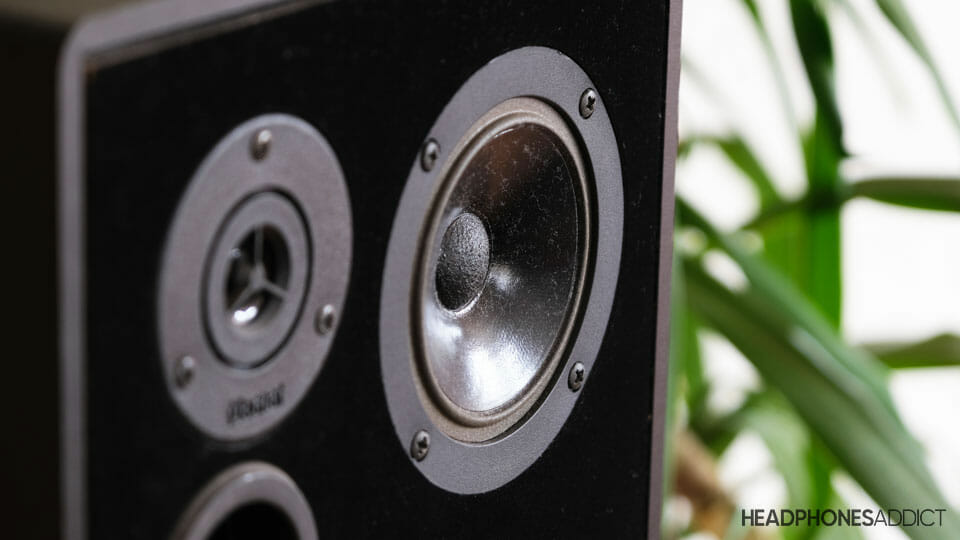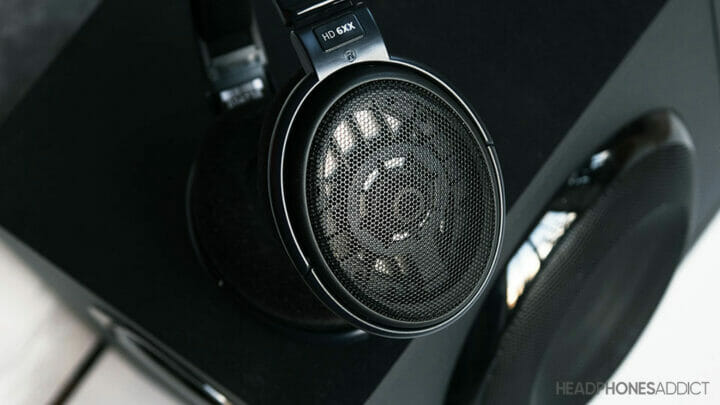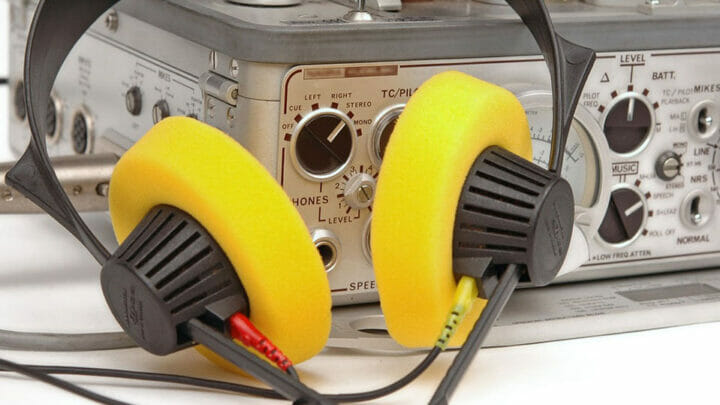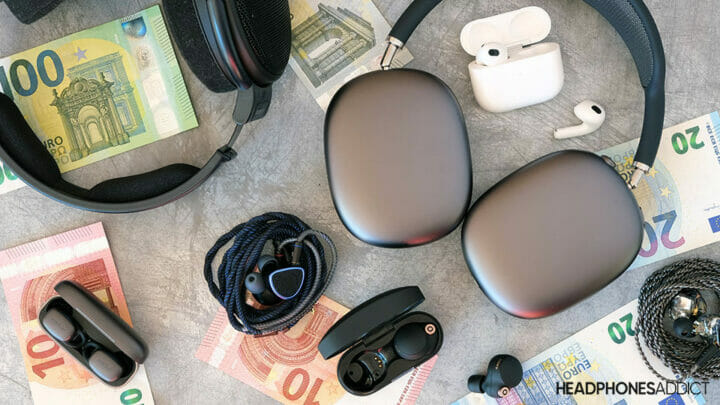The midrange represents frequencies between 250-4000Hz. It’s the frequency region where you hear vocals and instruments.
Learn how the midrange affects music and why it must be as neutral as possible.

What is Midrange in Music?
Midrange in music is mainly responsible for hearing vocals and instruments loud and clear. It makes them sound full and natural. And even small changes in midrange tuning can have a noticeable effect on how your music sounds.
Mid-frequencies range from 250Hz and 4000Hz and sit in the middle of the audible frequency range between the bass (below 250Hz) and treble (above 4.000Hz). That’s why it’s called the “midrange”.
Note that all frequency ranges (bass, midrange, and treble) work in synergy. If one range lacks or has too much energy, it affects the region next to it.
A tone played by a guitar consists of the primary frequency and other harmonic frequencies, which extend into highs and lows. Consequently, the tone sounds rich and full only when it has enough bass and treble presence.
Therefore, mids or midrange build a bridge between treble (highs) and bass (low) frequencies.
What is mid-frequency range
Midrange frequencies are located between 250Hz and 4000Hz, sandwiched between the bass (below 250Hz) and treble (above 4000Hz).
You can further dissect midrange into 3 sub-ranges. More on that later.

How Midrange Frequencies Affect Sound Quality
Midrange frequencies give the most presence to sounds like vocals and instruments.
Having a recessed midrange means that vocals and instruments take a “backseat”, sound quieter, and lack energy. In contrast, boosted mids make them too loud or honky/boxy.
We’ll show you the examples below.
Since human ear boosts midrange frequencies the most, recessed mids affect the perception of overall loudness. That also means the sound isn’t as lively, dynamic, and impactful.
As mentioned above, neighboring audio frequency ranges work in synergy. The lack of energy in one region affects how full the other region sounds.
That’s why the midrange is especially sensitive to the tuning of bass and treble.
Midrange impact on music genres
Since the mid-range is in the center of the audible frequency spectrum, it always plays an important role regardless of the music genre.
Generally, music genres the least affected by changes in the midrange are:
- Electronic music

Electronic music typically emphasizes bass and high-frequency effects, and it’s best to listen with headphones with a V-shaped sound signature.
That said, you can still hear a difference when using more balanced headphones, but the sound isn’t changed as severely as when listening to other types of music.
Genres most impacted by the midrange tuning are:
- Rock
- Classical
- Acoustic
- Jazz
Any music genre with lots of instrumentation and vocals slightly changes with different midrange tuning.

The midrange impact on vocals and instruments
Having to manually tune our headphone recordings for our reviews (how to understand sound comparisons), we know how vital midrange tuning is.
Vocals
- Lower mids. Boosting lower mids makes vocals too warm and muffled, whereas lowering them produces a thin human voice.
- Upper mids. Boosted higher midrange gives vocals more presence. But raising them too much can make them honky and thin, as if the singer has a clogged nose. On the flip side, lowering this range removes the presence and clarity of vocals.
Hear it for yourself in the video comparison below.
Instruments
Any deviation from the neutral target response significantly impacts musical instruments.
- Lower mids. Lowering the low midrange makes instruments sound muted and lifeless, whereas boosting makes them muddy.
- Upper mids. Lowering the high midrange reduces the loudness and presence of many instruments, whereas overly boosting them makes them harsh, especially electric guitars.

If you’re used to a specific sound signature, you don’t notice anything missing. But once you try more neutral headphones, some songs will sound entirely different.
Can too much midrange negatively impact audio quality?
Too much midrange can negatively impact audio quality by making audio too loud and harsh. Some might describe it as boxy (as if the sound resonates within a large box).
Midrange has to be tuned masterfully, especially on busy tracks with lots of instrumentation. Otherwise, it can quickly become an incoherent mess.
What is Midrange Quality?
Midrange quality is the headphones’ ability to recreate midrange audio spectrum faithfully and dynamically.
In general, midrange frequencies are the easiest for a headphone driver to play, as they require the least energy to do so.
On the other hand, they’re the hardest to tune perfectly by an audio engineer primarily because a small change can have a noticeable impact on how vocals or an instrument sounds.
Unlike bass frequencies, different driver types don’t have an impact on how they produce midrange. The only thing that matters is driver quality.
- Higher-quality drivers manage to produce a more dynamic, refined sound with greater detail retrieval.
- Lower-quality drivers can reproduce midrange faithfully, but they lack the impact and crispness of high-quality ones.
Here’s a video comparing two headphones with a widely different midrange quality:
What is Midrange Quantity?
Midrange quantity is the amount of energy mid-frequencies have, or how boosted/reduced they are. Basically, how loud the midrange is.
Human ears have evolved to naturally boost midrange frequencies the most. This range is primarily responsible for speech clarity and sounds that could alert us to nearby danger.
As a result, you can quickly have too much or too little midrange, so careful tuning is essential.
The video below shows how the same song sounds with a lot and very little midrange quantity:
A typical type of headphones that have a neutral midrange are headphones for mixing.
On the other hand, consumer headphones can have a slightly unbalanced midrange and still sound OK. For example, some added grittiness to electric guitars can make rock music more enjoyable.
Types of Midrange
The midrange (250Hz to 4000Hz) separates into 3 sub-regions:
- Lower mids range from 250Hz to 500Hz. It gives bass frequencies more presence, especially string instruments, and adds fullness to vocals.
- Mids range from 500Hz to 2000Hz. It gives presence to instruments and vocal clarity. Frequencies between 1000Hz and 3000Hz are especially sensitive to human hearing.
- Upper mids range from 2000Hz to 4000Hz. They are also boosted by human hearing. As they are responsible for vocals and instrumentation, too much of them can make the sound harsh and thin.
| Types of midrange | Frequency response range |
|---|---|
| Lower midrange | 250-500Hz |
| (Middle) midrange | 500-2000Hz |
| Upper midrange | 2000-4000Hz |
Here’s a video comparison showing what the lack of each midrange sub-range sounds like:
Frequently Asked Questions (FAQ)
What are midrange audio frequencies?
Midrange audio frequencies sit between 250Hz and 4000Hz and are responsible for adding loudness to most of the instruments and vocals.
What does too much midrange sound like?
Too much midrange sounds like the music is playing in an echoey box. It makes vocals sound thin, instruments harsh, and overly loud.
Does midrange affect bass?
Midrange affects bass perception by making it less tactile or crisp. That means bass kicks sound less punchy, despite having the same bass quantity.
Conclusion
Now you know why midrange is so necessary for music. While you can easily listen to music with little bass or treble, it becomes unlistenable without the midrange.
While a sound engineer can have a little bit of fun when tuning the midrange, even minor tweaks can make your headphones sound unnatural, thin, and boxy.
So even if you love bright or bassy headphones, ensure the mids are as balanced as possible.

From a childhood fascination with sound, Peter’s passion has evolved into a relentless pursuit of the finest headphones. He’s an audio expert with over 5 years of experience in testing both audiophile and consumer-grade headphones. Quote: “After many years, I can confidently tell which headphones are good and which are terrible.” Find his honest opinion in his reviews.






